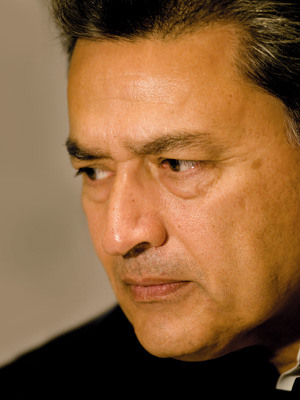
Rajat Gupta Does Not Take Witness Stand; Daughter Testifies Instead
The ex-McKinsey head's future is now in the hands of the 12-member jury which is deliberating whether he was guilty of insider trading
Rajat K Gupta is remarkably poised for a man who, if convicted of criminal conspiracy and securities fraud, could spend up to 20 years in jail.
The 63-year-old ex-McKinsey head and former director on the boards of Goldman Sachs and Proctor & Gamble must have walked into meetings in a similar dark blue suit, silk tie and crisp white shirt.
But on May 29, at the US District Court in the southern district of New York in Manhattan, he and his defence team from Kramer, Levin, Naftalis & Frankel LLP are fighting the fight of his life. Gary P Naftalis, the law firm’s co-chair, is one of America’s top white-collar defence lawyers.
“Gupta is lucky to have Naftalis,” says Stephen Gillers, professor of law at New York University, who has known both Naftalis and the presiding judge, Jed S Rakoff, for years. Gupta needs all the luck he can get.
In a six-count indictment, the US Department of Justice charged that Gupta “joined in an agreement or understanding” with Galleon Group’s Raj Rajaratnan, who is serving an 11-year prison sentence and was fined $156 million, “to disclose inside information about Goldman Sachs, P&G, and the JM Smucker Company.”
Prosecutors named Michael Cardillo and Ian Horowitz co¬-conspirators. Cardillo, a former Galleon trader, pleaded guilty of criminal charges last year. Horowitz is not indicted. The names of four others have been withheld.
But unlike Rajaratnam’s trial, where prosecutors presented direct evidence through wiretapped conversations, Gupta’s case so far is built on circumstantial, suggestive evidence consisting of hearsay conversations, indirect witness testimony, emails, Galleon trade records and Gupta’s and Rajaratnam’s phone logs.
The case smacks a bit of Sherlock Holmes. For example, the indictment states that on September 23, 2008, Gupta took part via telephone in a special meeting of the Goldman board, which approved a $5 billion investment from Berkshire Hathaway. Approximately 16 seconds after that call, Gupta’s assistant called Rajaratnam and connected Gupta to the call. Four minutes later at 3:58 pm, two minutes before close of market, Galleon Tech Funds bought approximately 2,17,200 shares of Goldman common stock for approximately $27 million.
Legal experts say although such evidence is not direct, it’s powerful and compelling. “The evidence against him is unusually strong—direct phone contact almost immediately after a crucial board meeting, followed by an immediate trade,” says Lynn A Stout, professor at Cornell Law School.
“It is possible to prove a criminal case by circumstantial evidence. Success is dependent on the prosecutor’s ability to present a series of facts that have only one reasonable interpretation—namely, that the defendant, in fact, gave inside information so that someone else could trade on it,” says Thomas Lee Hazen, professor at the University of North Carolina (Chapel Hill) School of Law.
And that’s exactly what assistant US attorneys Reed Brodsky and Richard Craig Tarlowe, appearing for US attorney Preet Bharara, are trying to construct. Their task is to prove beyond a reasonable doubt, to the 12-member federal jury of New Yorkers, who will determine Gupta’s fate, that it was he who tipped off Rajaratnam.
“The prosecutors need to prove Gupta’s guilt beyond a reasonable doubt, which is the most difficult standard to meet in our court system. Because the government does not have a single wiretap of Gupta providing insider information, but has hundreds of hours of wiretaps, the defence had much to work with in suggesting to the jury that Gupta was wrongly accused,” says Barry Slotnick, a white collar defence lawyer at Buchanan Ingersoll & Rooney PC in New York. He is not associated with the case.
Naftalis is doing everything he can to convince the jury that the government has put the wrong man on trial. The defence strategy is four-fold. One: Plant doubt in the minds of the jury that Rajaratnam could have had any number of inside sources. Two: Thoroughly discredit certain witnesses as liars. Three: Weaken the prosecution’s evidence as hearsay. Four: Given Gupta’s personal net worth of $84 million, argue that he would not have risked his reputation for financial gains. At one point, the defence team indicated the possibility of Gupta taking the witness stand, but eventually decided against it.
“I would have been shocked if he had taken the stand. The best defensive strategy is often to merely raise an inkling of doubt in the minds of jurors, and leave jurors with the impression that the government didn’t meet its high burden,” says Todd Henderson, professor of law at the University of Chicago Law School. “In fact, Gupta’s confidence and smarts might work against him as a witness, as it would be easier to set traps for him. The defence does not want this case to be about Gupta. It wants it to be about whether the government lawyers did their job. By putting a defendant on the stand, he is subject to very intense cross-examination, and this can undermine him in front of the jury. If it turns into a battle of whom you believe, jurors might pick the government.” Instead, Naftalis chose to possibly humanise Gupta by bringing in Gupta’s daughter Geetanjali as a witness.
In court, silver-haired Naftalis, 70, has an understated demeanour. But it would be a mistake to underestimate him. This is a man who managed to persuade the US government not to file criminal charges against Salomon Brothers for US Treasury auction bidding practices, and against securities firm Kidder, Peabody in connection to insider trading.
But the last few years have been rough for individuals facing white-collar charges. Bloomberg reported that since August 2009, 59 people pleaded guilty or were convicted out of a total of 66 who were charged with insider tipping. So far no one was found to be not-guilty and some cases are pending.
Naftalis has a soft but forceful way of poking holes. During a cross-examination of Jon Moeller, chief financial officer at P&G, he made Moeller acknowledge that several people besides Gupta, including employees at P&G and Smucker and their lawyers, were aware, prior to the announcement, about P&G’s impending sale of Folgers to Smucker.
Raj’s brother RK Rajaratnam on June 2, 2008, purchased 75,000 shares in Smucker. Naftalis said in court that there was nothing aberrational about the trade. He was head of Galleon’s consumer products team. “This is their pattern trade,” Naftalis said. Slowly and surely, he has steered the jury to possibly doubting the credibility of some witnesses. According to media reports, Naftalis is portraying Cardillo and other Galleon employees as merely bragging about having inside sources in high places.
The reports state Cardillo testified that RK Rajaratnam, for whom he made the trade, told him about “Raj’s guy on the P&G board.” Naftalis then brought up the name of George Soros, asking if it was not true that he’d heard Rajaratnam claim that he provided inside information to Soros on Intel. Cardillo admitted that he remembered something in connection with Intel and Soros.
The Wall Street Journal reported that a Soros spokesman said Soros did not receive any such information from Rajaratnam. Similarly, in his closing argument on June 13, Naftalis took a jab at Goldman Sachs chairman and CEO Lloyd Blankfein, a government witness, by discrediting his testimony. His contention: It is incredulous that Blankfein was unable to remember details of possible layoffs in 2008. The Journal quoted a Goldman spokesman who said Naftalis had misconstrued Blankfein’s comments. Blankfein remembers the potential layoffs, but not the specificities of his conversations.
Naftalis has had some gains and some losses. Gupta won a court order that requires prosecutors to disclose information to the defence attorneys that could enable them to show that he is innocent. But Judge Rakoff did not allow him to prevent prosecutors from showing wiretap evidence. Rakoff also did not permit the defence to play an August 2008 wiretap recording in court, which the defence claimed could show that Goldman top-ranking executive David Loeb most likely tipped off Rajaratnam.
Unrelated to this case, prosecutors have acknowledged previously that there is evidence against Loeb for insider trading concerning Intel Corp., Apple Inc. and Hewlett Packard. He has not been charged. Despite the setback in not being able to play the wiretap conversation between Rajaratnam and Loeb, the defence could have possibly scored a point with jurors. “The defence has raised a series of doubts by demonstrating that there were others [Loeb], that provided information about stocks in the same time period and that Gupta had a falling out with Rajaratnam prior to the time he is alleged to have provided him with insider information,” says Slotnick.
The tension is palpable among members of Gupta’s family. Waiting in the security line at the courthouse entrance, this Forbes India correspondent struck a conversation with a woman who said she was a member of Gupta’s family.
How is he holding up? “It is stressful, but he is not an ordinary man,” she said, looking both fragile and defiantly strong. It seems that Gupta was holding it together for all of them. At one point Judge Rakoff asked a juror to move to the front row, saying if this was a Broadway play, he won’t be able to afford the ticket. Gupta smiled.
Is the government particularly tough on him?
The persistent reference during the trial to other potential inside sources points to the large picture, and it’s not pretty. As Judge Rakoff said on May 29 in court when the jury was sequestered: “The most disturbing thing about this case is what it says about business ethics. It’s not a case of one bad apple, but a bushel.”
Not everyone agrees.
“I do not think insider trading of this sort should be illegal, especially not enforceable by criminal sanctions,” says law professor Henderson, who was formerly a McKinsey employee and worked directly under Anil Kumar. A Gupta protege, Kumar pleaded guilty for tipping off Rajaratnam and is now a key witness for the prosecution. In his testimony, Kumar said Rajaratnam and Gupta had a falling out after Gupta incurred losses on his investments with Rajaratnam’s firm. Former Galleon employee Isvari Mahadeva, a government witness, testified that Gupta invested $5 million in Voyager Capital Partners, a Galleon fund of funds, and exercised an option to invest an additional $10 million.
“That said, I think what Gupta allegedly did is illegal under current law, and I think it is likely he will be convicted,” Henderson adds. He is among a not-so-small group of legal eagles in the US who believe that there’s nothing wrong with this type of insider trading.
Prosecutors allege that on October 24, 2008, Rajaratnam sold Goldman stock after learning, allegedly from Gupta, that Goldman was losing $2 per share, which was worse than prevailing market expectations.
Henderson explains: “Take the case of Raj Rajaratnam’s trades in Goldman. He had information that the price of Goldman trading in the market was not accurate, and he traded to arbitrage this information. His trades provided information to the market about the true value of Goldman’s stock price. This is a public service, since the trades at the higher price were not an accurate reflection of the true value. The price was going to come down eventually, and I’m not sure why a big drop on an announcement is better than a gradual one based on insider trading. Now, it may be that Goldman may want to contract with its board members like Gupta, to prevent them from telling secrets to outsiders, but this should be a matter of private contract. If they aren’t harmed, it is hard for me to see the social harm.”
Federal prosecutors bristle at such a line of thinking. Sanjay Wadhwa, who is heading a parallel Securities and Exchange Commission case against Gupta, says there’s good reason why insider trading is illegal.
“The US markets are the envy of the world because there is transparency, there’s full and fair disclosure, and there’s an even landscape,” he says. “The markets are not supposed to be rigged in anybody’s favour. When you turn to insider trading, you undermine the core values of integrity and fairness that underlie our system. You victimise the marketplace and everyone else who participates in it. It’s hardly a victimless crime.”
But friends of Gupta maintain that the wrong man is on trial. “The government wants the jury to guess and imagine evidence and convict Rajat. That is not how the system works,” says Navneet S Chugh, an attorney at the Chugh Firm in California. “It’s clear that the government does not have a case and Rajat will be acquitted of all charges next week.”
The trial began on May 21. The prosecution rest its case on June 8 and the defence on June 12. Closing arguments were on June 13. The verdict is expected anywhere from a day or two to three weeks and more, depending on how long the jury deliberates. In Rajaratnam’s case, the jury deliberated for 12 days. Regardless of the outcome of this case, the SEC trial is scheduled to begin on October 1, 2012.
-
 Anu Anand
Anu Anandeven i have made back to back calls N there is a reason why coincidence means what it does. plus, what if he told the galleon guy that he should drop some other choice instead of telling him to go for goldman. maybe he said that there was something big going down in the that industry and the only possibility where that could\'ve happened was goldman. anyone who actually knows the industry would\'ve been able to tell where something could happen. of course i don\'t know what gupta said in his testimony and what rajaratnam said about the phone call. but if they didn\'t say something contradictory - the defence can use this too, although they\'ve, likely, already thought of this approach. btw, did we forget that there was no \'motive\' here in this case?
on Jun 22, 2012















